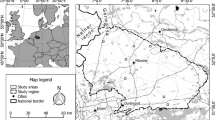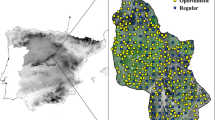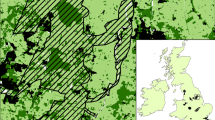Abstract
Context
Methods for measuring restoration success that include functional connectivity between species’ populations are rare in landscape ecology and restoration practices. We developed an approach that analyzes connectivity between populations of target species and their dispersal probabilities to assess restoration success based on easily accessible input data. Applying this method to landscape development scenarios can help optimize restoration planning.
Objectives
We developed an assessment for restoration success and restoration planning based on functional connectivity between species’ populations and spatially explicit scenarios. The method was used in a case study to test its applicability.
Methods
Based on data on available habitat, species’ occurrence and dispersal ranges, connectivity metrics and dispersal probabilities for target species are calculated using the software Conefor Sensinode. The metrics are calculated for scenarios that reflect possible changes in the landscape to provide a basis for future restoration planning. We applied this approach to floodplain meadows along the Upper Rhine for four plant species and three future scenarios.
Results
In the case study, habitats of the target species were poorly connected. Peucedanum officinale and Sanguisorba officinalis were more successful in recolonizing new habitats than Iris spuria and Serratula tinctoria. The scenarios showed that restoration of species-rich grassland was beneficial for dispersal of the target species. As expected in the agriculturally dominated study area, restoration of former arable land significantly increased dispersal probabilities.
Conclusions
In the case study, the developed approach was easily applicable and provided reasonable results. Its implementation will be helpful in decision-making for future restoration planning.





Similar content being viewed by others
References
Bakker JP, Berendse F (1999) Constraints in the restoration of ecological diversity in grassland and heathland communities. Trends Ecol Evol 14:63–68
Bakker JP, Poschlod P, Strykstra RJ, Bekker RM, Thompson K (1996) Seed banks and seed dispersal: important topics in restoration ecology. Acta Bot Neerl 45:461–490
Bekker RM, Verweij GL, Smith REN, Reine R, Bakker JP, Schneider S (1997) Soil seed banks in European grasslands: does land use affect regeneration perspectives? J Appl Ecol 34:1293–1310
Biolflor (Datenbank biologisch-ökologischer Merkmale der Flora von Deutschland) [Data base of the biological ecological attributes of the German flora]. http://www.biolflor.de. Accessed Aug 2016
Bischoff A (2001) Die Ausbreitung von Pflanzenarten in der Kulturlandschaft und ihre Bedeutung für Renaturierungsprozesse [The dispersal of plant species in the cultural landscape and its importance for restoration processes], Renaturierungsökologie der Gesellschaft für Ökologie (GfÖ) [Restoration ecology of the Association for Ecology], Burg (Spreewald), 21.-23.2.2001, BTUC-AR 7/2001, Brandenburgische Technische Universität (BTU), Cottbus, pp. 71–85
Bischoff A (2002) Dispersal and establishment of floodplain grassland species as limiting factors in restoration. Biol Conserv 104:25–33
Bischoff A, Warthemann G, Klotz S (2009) Succession of floodplain grasslands following reduction in land use intensity: the importance of environmental conditions, management and dispersal. J Appl Ecol 46:241–249
Bissels S, Donath TW, Hölzel N, Otte A (2005) Ephemeral wetland vegetation in irregularly flooded arable fields along the northern Upper Rhine: the importance of persistance seedbanks. Phytocoenologia 35:469–488
Blackstock TH, Rimes CA, Stevens DP, Jefferson RG, Robertson HJ, Mackintosh J, Hopkins JJ (1999) The extent of semi-natural grassland communities in lowland England and Wales: a review of conservation surveys 1978–96. Grass Forage Sci 54:1–18
Blaschke T (1999) Quantifizierung von Fragmentierung, Konnektivität und Biotopverbund mit GIS [Quantification of fragmentation, connectivity and habitat system with GIS]. In: Strobl J, Blaschke T (eds) Angewandte Geographische Informationsverarbeitung XI [Applied geographical data processing XI], Heidelberg
Botanische Vereinigung für Naturschutz in Hessen e.V. [BVNH] (2008) Rote Liste der Farn- und Samenpflanzen Hessens [Red List of the Ferns and Flowering plants of Hesse]. Hessisches Ministerium für Umwelt, Klimaschutz, Landwirtschaft und Verbraucherschutz, p 186
Burkart M (2001) River corridor plants (Stromtalpflanzen) in Central European lowland: a review of a poorly understood plant distribution pattern. Global Ecol Biogeogr 10:449–468
Burkart M, Dierschke H, Hölzel N, Nowak B, Fartmann T (2004) Molinio-Arrhenatheretea (E1)—Part 2: Molinietalia. In: Dierschke H (ed) Synopsis der Pflanzengesellschaften Deutschlands [Synopsis of the phytosociological alliances of Germany] 9, Floristic-Sociological Society and Reinhold-Tüxen-Society
Burmeier S, Eckstein RL, Otte A, Donath TW (2010) Dessiccation cracks act as natural seed traps in flood-meadow systems. Plant Soil 333:351–364
Burmeier S, Eckstein RL, Otte A, Donath TW (2011) Spatially-restricted plant material application creates colonization initials for flood-meadow restoration. Biol Conserv 144:212–219
Calabrese JM, Fagan WF (2004) A comparison-shoppers guide to connectivity metrics. Front Ecol Environ 2(10):529–536
Corporation Microsoft (2016) Microsoft Excel 2016. Redmond, Washington, USA
Distel R (2000) Graphentheorie [Graph Theory]. Springer, Heidelberg
Donath TW, Bissels S, Hölzel N, Otte A (2007) Large scale application of diaspore transfer with plant material in restoration practice—impact of seed and microsite limitation. Biol Conserv 138:224–234
Donath TW, Hölzel N, Otte A (2003) The impact of site conditions and seed dispersal on restoration success in alluvial meadows. Appl Veg Sci 6:13–22
Eckstein RL, Hölzel N, Danihelka J (2006) Biological Flora of Central Europe: Viola elatior, V. pumila, and V. stagnina. Perspect Plant Ecol Evol Syst 8:45–66
Eckstein RL, Otte A (2005) Effects of cleistogamy and pollen source on seed production and offspring performance in three endangered violets. Basic Appl Ecol 6:339–350
Erikson O, Ehrlén J (2001) Landscape fragmentation and the viability of plant populations. In: Silverstone J, Antonovics J (eds) Integrating ecology and evolution in a spacial context. Blackwell Science Ltd, Oxford
Ewers RM, Thorpe S, Didham RK (2007) Synergistic interactions between edge and area effects in a heavily fragmented landscape. Ecology 88(1):96–106
Forman RTT (1995) Land mosaics: the ecology of landscapes and regions. Cambridge University Press, Cambridge
Gerard M, El Kahloun M, Mertens W, Verhagen B, Meire P (2008) Impact of flooding on potential and realised grassland species richness. Plant Ecol 194:85–98
Hanski I, Gilpin M (1991) Metapopulation dynamics: brief history and conceptual domain. Biol J Linn Soc 42:3–16
Hodgson J, Thomas CD, Wintle BA, Moilanen A (2009) Climate change, connectivity and conservation decision making—back to basics. J Appl Ecol 46:964–969
Hodvina S, Cezanne R, Harnisch M, Donath TW (2007) Die Wiesen-Schwertlilie (Iris spuria) in Hessen [The Blue Iris (Iris spuria) in Hesse]. Botanik und Naturschutz in Hessen, vol 19, Frankfurt am Main, pp 69–97
Hölzel N (1999) Flora und Vegetation der Auenwiesen im NSG ‘Lampertheimer Altrhein’ – eine aktuelle Zustandsanalyse mit Hinweisen zur zukünftigen Pflege und Entwicklung [Flora and vegetation of the floodplain meadows in the nature conservation area ‘Lampertheimer Altrhein’—a current state analysis with recommendations for further management and development]. Jahrb Natursch Hessen [Hessian yearbook for nature conservation] 4:24–42
Hölzel N, Otte A (2003) Restoration of a species-rich flood meadow by topsoil removal and diaspore transfer with plant litter. Appl Veg Sci 6:131–140
Hölzel N, Otte A (2004) Assessing soil seed bank persistence in flood-meadows: which are the easiest and most reliable traits? J Veg Sci 15:93–100
Hundt R (1996) Zur Veränderung der Wiesenvegetation Mitteldeutschlands unter dem Einfluß einer starken Bewirtschaftungsintensität [Changes in meadow vegetation of Central Europe under the influence of a highly intensive management]. Berichte der Reinhold-Tüxen-Gesellschaft 8:127–143
Hutchings MJ, Booth KD (1996) Sudies on the feasibility of re-creating chalk grassland vegetation on ex-arable land. I.The potential roles on the seed bank and the seed rain. J Appl Ecol 33:1171–1181
Joyce CB, Wade MW (1998) Wet grasslands: a European perspective. In: Joyce CB, Wade PM (eds) European wet grasslands: biodiversity, management and restoration. John Wiley, Chichester, pp 1–12
Kéry M, Matthies D, Spillmann H-H (2000) Reduced fecundity and offspring performance in small populations of the declining grassland plants Primula veris and Gentiana lutea. J Ecol 88:17–30
Kiehl K, Kirmer A, Donath TW, et al (2010) Species introduction in restoration projects – Evaluation of different techniques for the establishment of semi-natural grasslands in Central and Northwestern Europe. Basic Appl Ecol 11:285–299. https://doi.org/10.1016/j.baae.2009.12.004
Kolb A (2005) Reduced reproductive success and offspring survival in fragmented populations of the forest herb Phyteuma spicatum. J Ecol 93:1226–1237
Lang S, Tiede D (2003) vLATE Extension für ArcGIS - vektorbasiertes Tool zur quantitativen Landschaftsstrukturanalyse [vLATE extension for ArcGIS – vector based tool for quantitative analyses of landscape structure], Salzburg
LEPIDAT (Datenbank zur Biologie und Gefährdung von Schmetterlingen am Bundesamt für Naturschutz) [Data base of the biology and endangerment of butterflies of the Federal Office for Nature Conservation]. http://www.lepidat.org. Accessed August 2016
Ludwig G, Schnittler M (1996) Rote Liste gefährdeter Pflanzen Deutschlands [Red List of endangered plants in Germany]. BfN, Bonn
McGarigal K (2002) Landscape pattern metrics. In: El-Shaarawi AH, Piegorsch WW (eds) Encyclopedia of environmentrics, pp 1135–1142
Merken R, Deboelpaep E, Teunen J, Saura S, Koedam N (2015) Wetland suitability and connectivity for trans-Saharan migratory waterbirds. Plos ONE. https://doi.org/10.1371/journal.pone.0135445
Moilanen A, Franco AMA, Early RI, Fox R, Wintle B, Thomas CD (2005) Prioritizing multiple-use landscapes for conservation: methods for large multi-species planning problems. Proc R Soc Lond B 272:1885–1891
Müller-Westermeier G (1990) Klimadaten der Bundesrepublik Deutschland [Climate data of the Federal Republic of Germany]. Deutscher Wetterdienst [German Weather Service], Offenbach
Nassauer JI, Corry RC (2004) Using normative scenarios in landscape ecology. Landscape Ecol 19:343–356
Neel MC (2008) Patch connectivity and genetic diversity conservation in the federally endangered and narrowly endemic plant species Astragalus albens (Fabaceae). Biol Conserv 141:938–955
Öckinger E, Lindborg R, Sjödin NE, Bommarco R (2012) Landscape matrix modifies richness of plants and insects in grassland fragments. Ecography 35:259–267
Palmer MA, Ambrose RF, Poff NL (1997) Ecological theory and community restoration ecology. Restor Ecol 5:291–300
Pascual-Hortal L, Saura S (2006) Comparison and development of new graph-based landscape connectivity indices: towards the priorization of habitat patches and corridors for conservation. Landscape Ecol 21(7):959–967
Perry GLW, Moloney KA, Etherington TR (2017) Using network connectivity to prioritise sites for the control of invasive species. J Appl Ecol 54:1238–1250
R Core Team (2016) R: a language and environment for statistical computing. R Foundation for Statistical Computing, Vienna, Austria. https://www.R-project.org/
Saura S, Pascual-Hortal L (2007) A new habitat availability index to integrate connectivity in landscape conservation planning: comparison with existing indices and application to a case study. Landsc Urban Plan 83:91–103
Saura S, Rubio L (2010) A common currency for the different ways in which patches and links can contribute to habitat availability and connectivity in the landscape. Ecography 33:523–537
Saura S, Torné J (2007) Conefor Sensinode 2.2: Software for quantifying the importance of habitat patches for landscape connectivity through graphs and habitat availability indices. University Lleida, Spain
Saura S, Torné J (2009) Conefor Sensinode 2.2: a software package for quantifying the importance of habitat patches for landscape connectivity. Environ Modell Softw 24:135–139
Schröter L, Irmler U (2013) Organic cultivation reduces barrier effect of arable fields on species diversity. Agric Ecosyst Environ 164:176–180
The Council of the European Communities (1992) Council Directive 92/43/EEC of 21 May 1992 on the conservation of natural habitats and of wild fauna and flora, consolidated version 01.01.2007
Thompson K, Bakker JP, Bekker RM (1997) The soil seed bank of North Western Europe: methodology, density and longevity. Cambridge University Press, Cambridge
Tilman D (1997) Community invisibility, recruitment limitation and grassland biodiversity. Ecology 78:81–92
Trainor AM, Walters JR, Urban DL, Moody A (2013) Evaluating the effectiveness of a Safe Harbor Program for connecting wildlife populations. Anim Conserv 16:610–620
Von Blanckenhagen B, Poschlod P (2005) Restoration of calcareous grasslands: the role of the soil seed bank and seed dispersal for recolonisation processes. Biotechnol Agron Soc Environ 9:143–149
Wärner C, Wosniok W, Diekmann M (2014) River corridor plants in North-western Germany are threatened by small population size and short-term environmental events. Tuexenia: Mitteilungen der Floristisch-Soziologischen Arbeitsgemeinschaft 34: 233–245
Wickham H (2009) ggplot2: elegant graphics for data analysis. Springer, New York
Winter C, Lehmann S, Diekmann M (2008) Determinants of reproductive success: a comparative study of five endangered river corridor plants in fragmented habitats. Biol Conserv 141:1095–1104
With KA, Gardner RH, Turner MG (1997) Landscape connectivity and population distributions in heterogeneous environments. Oikos 78:151–169
Acknowledgements
We are grateful for the continuous support and data provided by the City of Riedstadt, especially by Matthias Harnisch. Geodata were provided by the HVBG (Hessian Administration for Soil Management and Geographical Information). We thank RP Darmstadt for the permission to survey our target species in the Nature Conservation areas located in our study area. We also thank R. Lutz Eckstein and Tobias W. Donath, as well as two anonymous reviewers, for helpful comments on the manuscript.
Author information
Authors and Affiliations
Corresponding author
Ethics declarations
Conflict of interest
The authors declare that they have no conflict of interest.
Rights and permissions
About this article
Cite this article
Volk, X.K., Gattringer, J.P., Otte, A. et al. Connectivity analysis as a tool for assessing restoration success. Landscape Ecol 33, 371–387 (2018). https://doi.org/10.1007/s10980-018-0611-6
Received:
Accepted:
Published:
Issue Date:
DOI: https://doi.org/10.1007/s10980-018-0611-6




